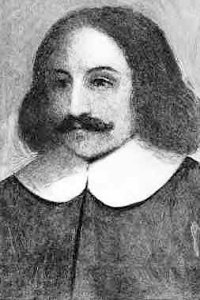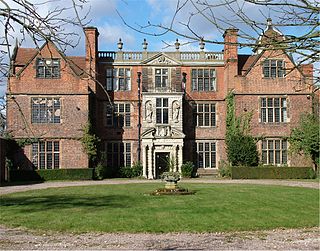
John Alden was a crew member on the historic 1620 voyage of the Mayflower which brought the English settlers commonly known as Pilgrims to Plymouth Colony in Massachusetts. He was hired in Southampton, England as the ship's cooper, responsible for maintaining the ship's barrels. He was a member of the ship's crew and not a settler, yet he decided to remain in Plymouth Colony when the Mayflower returned to England. He was a signatory to the Mayflower Compact.

The Pilgrims, also known as the Pilgrim Fathers, were a minority the English settlers who traveled to America on the Mayflower and aided in establishing the Plymouth Colony in Plymouth, Massachusetts. The Pilgrims' leadership came from the religious congregations of Brownists, or Separatist Puritans, who had fled religious persecution in England for the tolerance of 17th-century Holland in the Netherlands.

Myles Standish was an English military officer and colonist. He was hired as military adviser for Plymouth Colony in present-day Massachusetts, United States by the Pilgrims. Standish accompanied the Pilgrims on the ship Mayflower and played a leading role in the administration and defense of Plymouth Colony from its foundation in 1620. On February 17, 1621, the Plymouth Colony militia elected him as its first commander and continued to re-elect him to that position for the remainder of his life. Standish served at various times as an agent of Plymouth Colony on a return trip to England, as assistant governor of the colony, and as its treasurer.

The Mayflower Compact, originally titled Agreement Between the Settlers of New Plymouth, was the first governing document of Plymouth Colony. It was written by the men aboard the Mayflower, consisting of Separatist Puritans, adventurers, and tradesmen. Although the agreement contained a pledge of loyalty to the King, the Puritans and other Protestant Separatists were dissatisfied with the state of the Church of England, the limited extent of the English Reformation and reluctance of King James I of England to enforce further reform.

Plymouth Colony was the first permanent English colony in New England from 1620 to 1691 and the second permanent English colony in America, after the Jamestown Colony. It was settled by the passengers on the Mayflower at a location that had previously been surveyed and named by Captain John Smith. The settlement served as the capital of the colony and developed as the town of Plymouth, Massachusetts. At its height, Plymouth Colony occupied most of the southeastern portion of Massachusetts. Many of the people and events surrounding Plymouth Colony have become part of American folklore, including the American tradition of Thanksgiving and the monument of Plymouth Rock.

William Bradford was an English Puritan Separatist originally from the West Riding of Yorkshire in Northern England. He moved to Leiden in Holland in order to escape persecution from King James I of England, and then emigrated to the Plymouth Colony on the Mayflower in 1620. He was a signatory to the Mayflower Compact and went on to serve as Governor of the Plymouth Colony intermittently for about 30 years between 1621 and 1657. He served as a commissioner of the United Colonies of New England on multiple occasions and served twice as president. His journal Of Plymouth Plantation covered the years from 1620 to 1646 in Plymouth.

The Virginia Company was an English trading company chartered by King James I on 10 April 1606 with the object of colonizing the eastern coast of America. The coast was named Virginia, after Elizabeth I, and it stretched from present-day Maine to the Carolinas. The company's shareholders were Londoners, and it was distinguished from the Plymouth Company, which was chartered at the same time and composed largely of gentlemen from Plymouth, England.

John Carver was one of the Pilgrims who braved the Mayflower voyage in 1620 which resulted in the creation of Plymouth Colony in America. He is credited with writing the Mayflower Compact and was its first signer, and he was also the first governor of Plymouth Colony.

The Plymouth Company, officially known as the Virginia Company of Plymouth, was a company chartered by King James in 1606 along with the Virginia Company of London with responsibility for colonizing the east coast of America between latitudes 38° and 45° N.
USS Plymouth was a sloop-of-war constructed and commissioned just prior to the Mexican–American War. She was heavily gunned, and traveled to Japan as part of Commodore Matthew C. Perry's effort to force Japan to open her ports to international trade. She also served in European and Caribbean waters and, later in her career, she was used to train midshipmen.

The Jacobean style is the second phase of Renaissance architecture in England, following the Elizabethan style. It is named after King James VI and I, with whose reign it is associated. At the start of James' reign there was little stylistic break in architecture, as Elizabethan trends continued their development. However, his death in 1625 came as a decisive change towards more classical architecture, with Italian influence, was in progress, led by Inigo Jones; the style this began is sometimes called Stuart architecture, or English Baroque.
The New World Tapestry was for a time the largest stitched embroidery in the world. It depicts English colonisation in North America, Guyanas, and Bermuda between the years 1583 and 1642, when the English Civil War began.

USS Middlesex County (LST-983) was an LST-542-class tank landing ship built for the United States Navy during World War II. Named after counties in Connecticut, Massachusetts, New Jersey, and Virginia, she was the only United States Navy vessel to bear the name.

Amherst-Plymouth Wildlife Management Area is a 7,061-acre (2,857 ha) protected area located in Putnam County, West Virginia. The site is along the banks of the Kanawha River and is popular for hunting Canada geese in the fall. Access is from West Virginia Route 62 between Bancroft and Hometown and from Manilla Creek Road and Heizer Creek Road off WV 62 north of Poca, West Virginia. Manilla Creek Road cuts across the north side of the Amherst-Plymouth WMA, and WV 62 follows the southern edge of the area alongside the Kanawha River.

Mayflower was an English ship that transported a group of English families, known today as the Pilgrims, from England to the New World in 1620. After a grueling 10 weeks at sea, Mayflower, with 102 passengers and a crew of about 30, reached what is today the United States, dropping anchor near the tip of Cape Cod, Massachusetts, on November 21 [O.S. November 11], 1620.

The New England Colonies of British America included Connecticut Colony, the Colony of Rhode Island and Providence Plantations, Massachusetts Bay Colony, Plymouth Colony, and the Province of New Hampshire, as well as a few smaller short-lived colonies. The New England colonies were part of the Thirteen Colonies and eventually became five of the six states in New England, with Plymouth Colony absorbed into Massachusetts and Maine separating from it. Captain John Smith's 1616 work A Description of New England first applied the term "New England" to the coastal lands from Long Island Sound to Newfoundland.
In the fall of 1621 the Fortune was the second English ship destined for Plymouth Colony in the New World, one year after the voyage of the Pilgrim ship Mayflower. Financed as the Mayflower was by Thomas Weston and others of the London-based Merchant Adventurers, Fortune was to transport thirty-five settlers to the colony on a ship that was much smaller than Mayflower. The Fortune required two months to prepare for the voyage and once underway, reached Cape Cod on 9 November 1621 and the colony itself in late November. The ship was unexpected by those in the Plymouth colony and although it brought useful settlers, many of whom were young men, it brought no supplies, further straining the limited food resources of the colony. The ship only stayed in the colony for about three weeks, returning to England in December loaded with valuable furs and other goods. But when nearing England, instead of heading to the English Channel, a navigation error caused the ship to sail southeast to the coast of France, where it was overtaken and seized by a French warship.

The Mayflower Compact was an iconic document in the history of America, written and signed aboard the Mayflower on November 11, 1620 while anchored in Provincetown Harbor in Massachusetts. The Compact was originally drafted as an instrument to maintain unity and discipline in Plymouth Colony, but it has become one of the most historic documents in American history. It was published in London in Mourt's Relation in 1622, and the authors had added a preamble to clarify its meaning: "it was thought good there should be an association and agreement, that we should combine together in one body, and to submit to such government and governors as we should by common consent agree to make and choose."
















